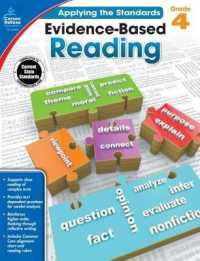- ホーム
- > 洋書
- > 英文書
- > Psychology
Full Description
Effective Learning After Acquired Brain Injury provides clear guidance on delivering productive educational programmes for adolescents and adults with acquired brain injury (ABI). Written for the non-specialist, the book provides an accessible overview of the neuropsychological deficits resulting from ABI and the ways in which these can affect an individual's ability to learn and to benefit from educational programmes.
This is the first book of its kind to focus on the adaptation of educational programmes for adults rather than children. The authors explain how to take the results of a neuropsychological assessment as a guide in order to construct a cognitive profile and to create individually tailored educational plans and rehabilitation programmes. They also describe specific strategies that can be taught or utilised, and ways in which they can be set out in a simple plan. The book includes an extensive collection of resources which can be reproduced for the reader's own use.
Effective Learning After Acquired Brain Injury will be an invaluable resource for general facilitators, clinicians and practitioners who provide educational opportunities in rehabilitation centres for individuals with a variety of neurological conditions, and also for those delivering education in forensic settings. It will maximise the quality of teaching, and the person's potential to learn, and improve the success rate of rehabilitation programmes and those aimed at reducing offending.
Contents
Introduction Part one: The Brain and How it May be Damaged 1. Brain Anatomy and Functions 2. Acquired Brain Injury (ABI) 3. Developmental Issues Part Two: Brain Injuries and Neuropsychological Impairments 4. Physical, Sensory, Perceptual and Mood Deficits 5. Attention Deficits 6. Memory Deficits 7. Executive Function Deficits 8. Speed of Information Processing Deficits 9. Speech and Communication Deficits Part Three: Managing Neuropsychological Difficulties 10. Understanding Neuropsychological Assessments 11. Managing Behaviours 12. Some General Learning Strategies 13. Basing Cognitive Profiles on Neuropsychological Assessments 14. Individual Education Plans Part Four: Appendices Appendix A Strategies for Attention Deficits Appendix B Strategies for Memory Deficits Appendix C Strategies for Executive Function Deficits Appendix D Strategies for Speed of Information Processing Deficits Appendix E Strategies for Language and Communication Deficits Appendix F Case Studies Appendix G ABC Chart Appendix H ABCIO Chart Appendix I Sample Individual Education Plans








